Rice with Potato Tahdig is a traditional Persian recipe where fluffy grains of rice are encased in a crispy shell with fried potatoes. Wow your friends and family with this beautiful and delicious side dish.
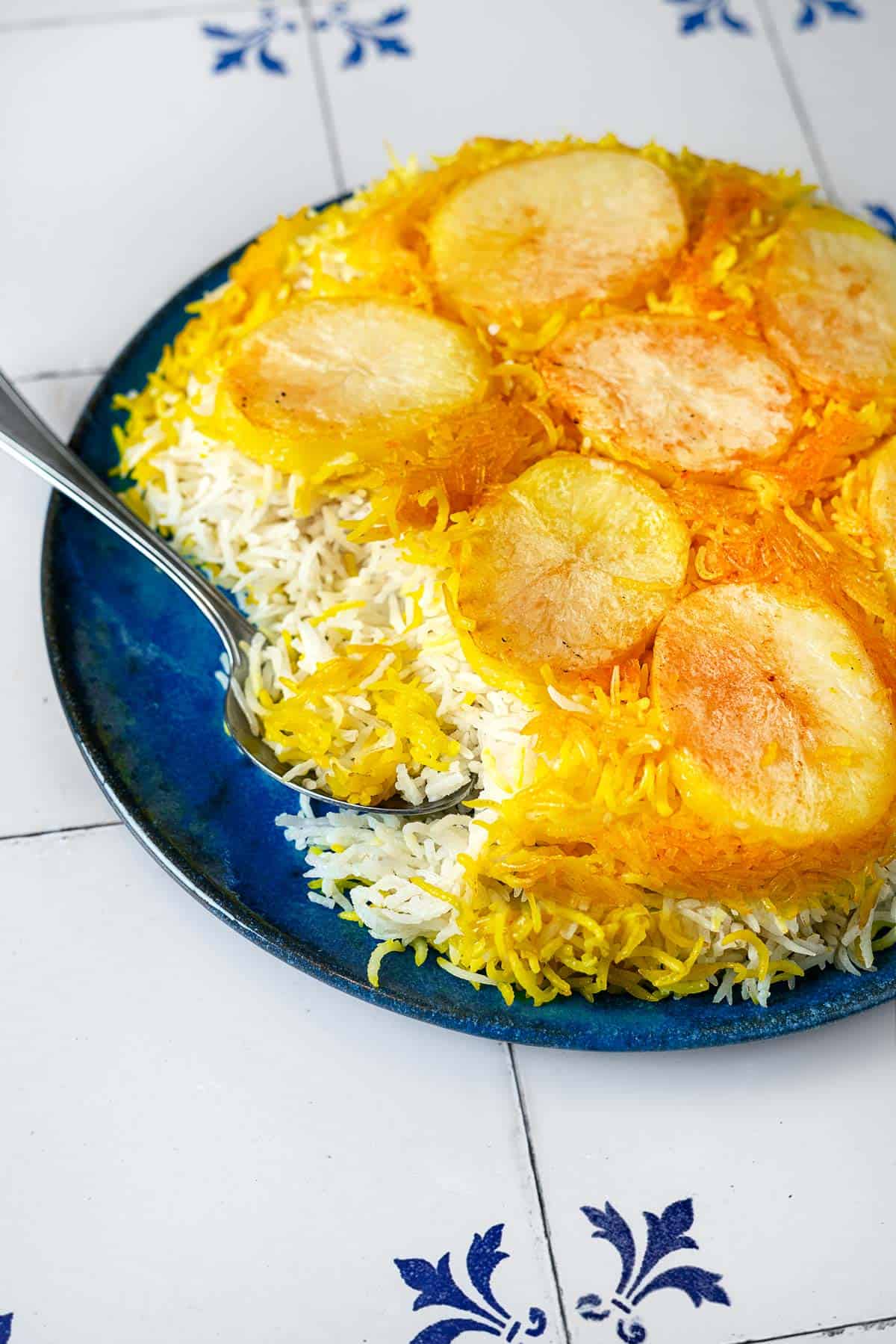
Persian rice with Potato Tahdig is a showstopping way to serve rice for your family or guests, and it’s the perfect accompaniment for Fesenjan (Persian chicken and walnut stew) or grilled meat like Kofta Kebabs. Don’t worry this rice dish also goes well with vegetarian dinners. Try it with this gorgeous Whole Roasted Cauliflower.
For most Iranians, this is the best way to cook rice. It yields tender, fluffy grains with a crispy layer, called Tahdig, that can include potatoes as I do in this recipe, chicken, lettuce, or bread. You can also keep it really simple with just crispy rice.
Tahdig translated from Persian to English means ‘bottom of the pot’ and refers to the crispy layer formed as a result of the cooking process. The bottom layer of the rice dish is fried in a little oil, which creates a crunchy casing, while the rest of the rice steams. The sliced potatoes in this recipe become fluffy on the inside and crispy on the outside.
Tahdig is one of the most cherished elements of a Persian meal and there is never any leftover! It is out of this world delicious and I’m pretty sure once you have made and eaten this dish cooking rice this way will be a regular occurrence for you!
Table of Contents
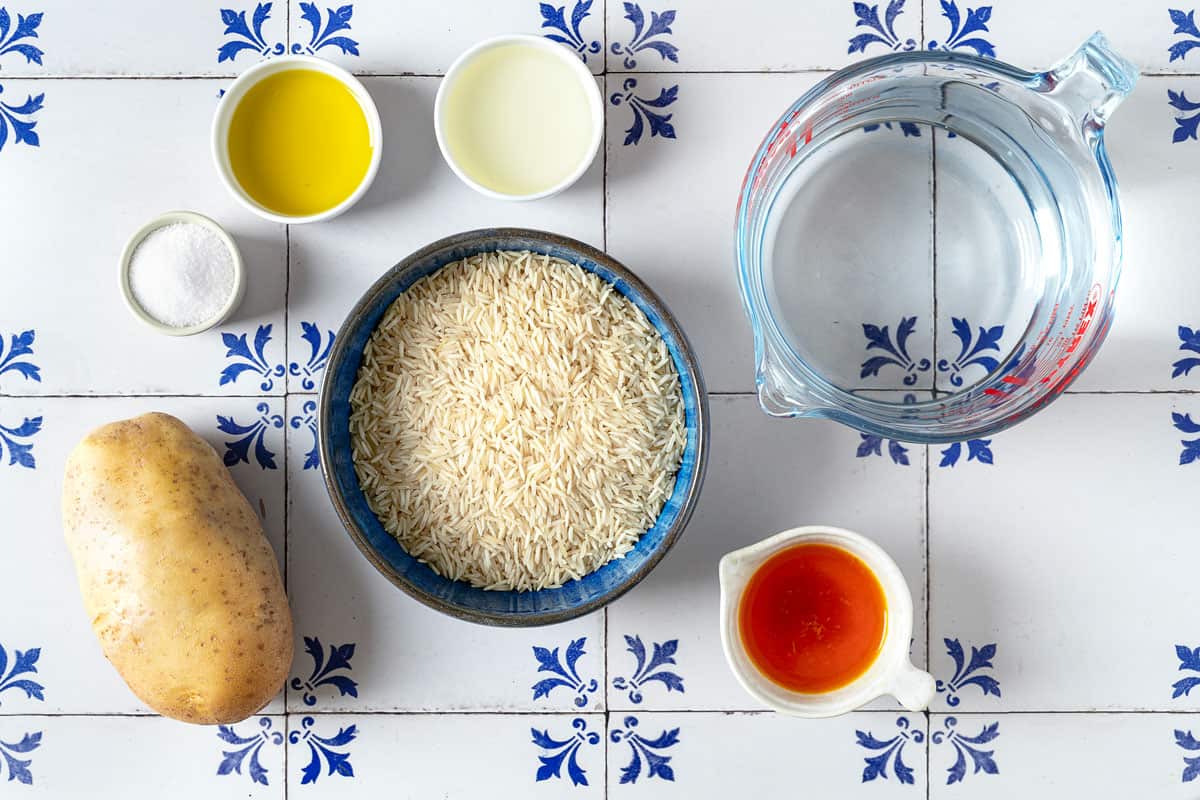
What You Need to Make Rice with Potato Tahdig
Most of the ingredients for this recipe, aside from saffron, are pretty easy to come by. You can find saffron in specialty spice stores, specialty grocery stores, and Middle Eastern markets.
- Basmati rice: This is a long grain, aromatic rice perfect for creating Persian rice dishes.
- Potato: I like to use a general purpose potato, like Yukon Golds or Russets to make the tahdig layer.
- Saffron: I use saffron to create an aromatic and golden hued layer of rice under the tahdig. The floral perfume it adds to the rice’s aromatic note is dreamy.
- READ MORE: What Is Saffron? An Essential Guide
- TRY IT: Order from our Spice Shop.
- Neutral oil: I use vegetable or grapeseed oil for the Tahdig.
- Olive oil or butter: Either one will help fluff and separate the rice once it is cooked. Traditionally Persians use melted butter or ghee to drizzle over the rice prior to steaming it. Substituting with olive oil, like our Arbequina California EVOO, makes a healthier version.
- Kosher salt: Salt is essential for seasoning the rice and to highlight all the other flavors in the dish.
How to Make Rice with Potato Tahdig
Making Persian rice and Potato Tahdig can seem intimidating, but follow this easy recipe and you too can become a veteran at making this dish. A few tips before you get started: Use a non-stick pot with a lid to aid you in the cooking process and final presentation. Also, make sure you have a clean tea towel to wrap around the pot’s lid to absorb extra moisture.
- Rinse and soak the rice: Rinse 2 cups of rice with cold water until the water runs clear. Place in a bowl and add cold water until the rice is covered by two inches of water. Leave to soak overnight.
- Prepare the potato: Prior to cooking the rice, peel 1 medium sized potato (or more as needed depending on the size of your pan). Then slice into 1/2-inch-thick slices. Place the sliced potatoes into a bowl of water and leave until ready to use.
- Bloom the saffron: Grind the saffron threads in a mortar and pestle or spice grinder, then put 1/4 teaspoon ground saffron into a medium-sized bowl. (You will add some rice to this bowl later.) Add 3 tablespoons of water and set it aside. The saffron will infuse the water and “bloom.”
- Parboil the rice: In a large non-stick pot, combine 8 cups of water and 2 tablespoons of salt. Bring to a boil over high heat. Drain the rice of the soaking water, then add rice to the boiling water. Stir and cook until al dente, 5 to 7 minutes. Turn heat off and drain the rice into a colander. Rinse out the pot you cooked the rice in and place on the stove.
- Prepare the Tahdig layer: Drain the potato slices and dry them with a paper towel. Sprinkle a little salt on the potatoes. Pour 2 tablespoons of neutral flavoured oil into the pot. Layer the potato slices on the bottom of the pot, ensuring they do not overlap.
- Layer the rice: Take 1 cup of the cooked rice and add to the bloomed saffron and mix until it is fully coated and golden colored. Layer over the potato slices in the pot and pat down flat with the back of the spoon. Then layer the remaining white rice and drizzle with a little olive oil after each layer. Pat the rice firmly down and poke 5 holes evenly across with the end of the spoon. Pour two tablespoons of water over the rice.
- Steam the rice: Put the lid on the saucepan and turn the heat to high. Once steam starts to rise, reduce heat to the lowest setting. Take a tea-towel, wrap it round the lid and place it back on the pot. Steam for 1 hour.
- Serve the rice: Remove the lid, invert a large serving plate over the pot, and carefully flip them over together. The rice and tahdig should come out like a cake. Don’t worry if the tahdig sticks, just scrape it out and arrange it around the rice on the serving plate.
How to Store Persian Steamed Rice with Potato Tahdig
Cooked rice will keep for up to 5 days when stored in an airtight container in the fridge. Be sure to allow the rice to cool before placing it in the fridge.
To Freeze: You can freeze the rice. Allow it to cool completely, then transfer to freezer bags or containers. It will last for up to 3 months in the freezer.
To reheat: I anticipate you will not have any tahdig left, but if you do it can be rejuvenated by crisping it up in a hot oven or an airfryer! Splash a little water over the rice and cook on low heat on the stove. You can also reheat in the microwave using the appropriate microwave dish.
What to Serve With Steamed Rice with Potato Tahdig
Persian rice with Potato Tahdig is a beautiful centerpiece on the dining table. While this recipe is easy enough for a weeknight dinner, I especially like to serve Tahdig on a special occasion with other wow-worthy entrees that can hold their own. It’s a classic pairing for Fesenjan, Persian chicken and walnut stew, or Ghormeh Sabzi, Persian Beef Stew with Herbs and Dried Lime.
Grilled meat like Kofta Kebabs or Creamy Saffron Chicken with Vegetables are all worthy of a place at the table alongside a crispy Persian rice tahdig. Or, try a showy vegetarian main like Whole Roasted Cauliflower.
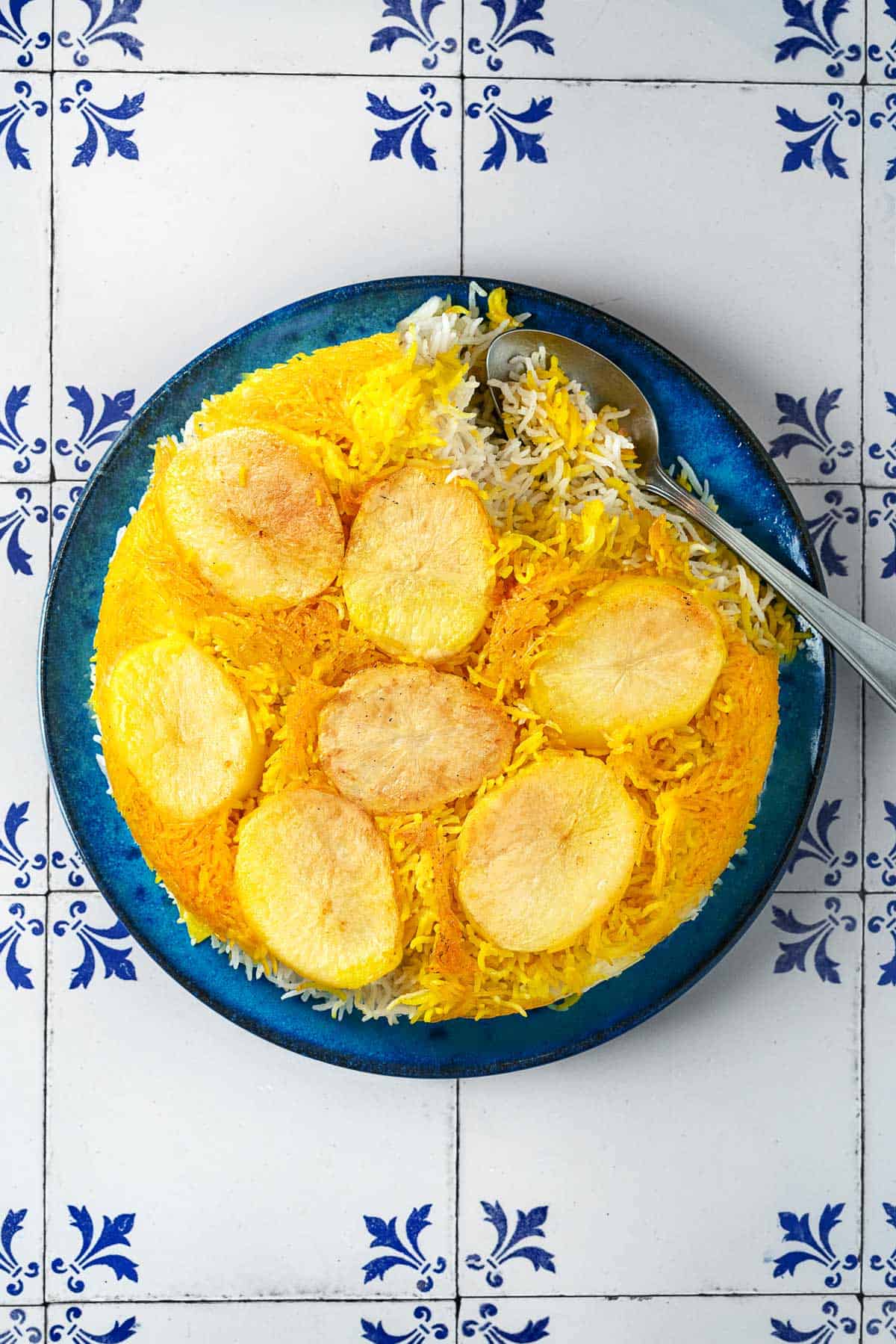
More Amazing Rice Recipes
Lebanese
Lebanese Rice with Vermicelli
Sides and Small Plates
No-Fail Basmati Rice (Stovetop & Rice Cooker)
Browse all Mediterranean recipes.
Visit Our Shop.
Arbequina – California EVOO
Skip the butter! We love to finish this potato tahdig with a drizzle of our smooth, mild-intensity Arbequina Extra Virgin Olive Oil instead.
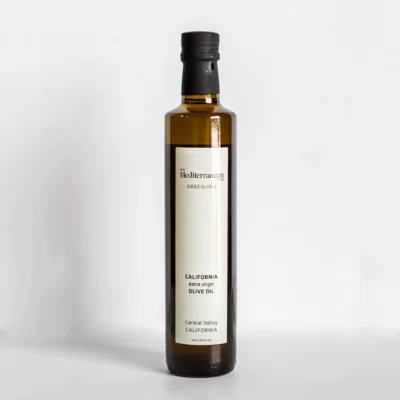
Persian Rice with Potato Tahdig

Ingredients
- 2 cups Basmati Rice
- 1 medium potato (or more depending on the size of your pan)
- 2 tablespoons neutral oil (like vegetable or grapeseed)
- Extra virgin olive oil, for drizzling
- 1/4 teaspoon ground saffron (or about 14 whole threads)
- 2 tablespoons kosher salt, plus more for seasoning
Instructions
- Rinse and soak the rice: Rinse 2 cups of rice with cold water until the water runs clear. Place in a bowl and cover with cold water two inches above the rice. Leave to soak overnight.
- Prepare the potato: Prior to cooking the rice, peel and slice enough ½-inch-thick potato slices to cover the bottom of your pan. Place the sliced potatoes into a bowl of water and leave until ready to use.
- Bloom the saffron: If you're using whole saffron threads, place in a spice grinder or mortar and pestle and grind into a fine powder. Put 1/4 teaspoon of the ground saffron into a medium-sized bowl. (You will add rice to it later.) Add 3 tablespoons of water and set aside. The saffron will infuse the water and “bloom.”
- Parboil the rice: In a large non-stick pot with high sides, combine 8 cups of water and 2 tablespoons of salt. Bring to a boil over high heat. Add the rice, stir, and cook until al dente, 5 to 7 minutes. Turn heat off. Drain the rice, rinse out the pot you cooked the rice in and place the pot back on the stove.
- Prepare the Tahdig layer: Drain the potato slices and dry them with a paper towel. Sprinkle a little salt on the potatoes. Pour 2 tablespoons of vegetable or grapeseed oil into the pot. Layer the potato slices on the bottom of the pot, ensuring they do not overlap.
- Layer the rice: Take 1 cup of cooked rice and add it to the bloomed saffron. Mix until it’s fully coated and golden. Layer over the potato slices in the pot and pat down flat with the back of the spoon. Add a drizzle of olive oil, then layer with the white rice and drizzle with a little olive oil. Pat the rice firmly down and poke 5 holes evenly across with the handle of the spoon. Pour 2 tablespoons of water over the rice.
- Steam the rice: Put the lid on the saucepan and turn the heat to high. Once steam starts to rise, reduce heat to the lowest setting. Take a tea towel, wrap it around the lid, and place it back on the pot. Steam for 1 hour on low heat.
- Serve the rice: Remove the lid, invert a large serving plate over the pot, and carefully flip them over together. The rice and tahdig should come out like a cake. Don’t worry if the tahdig sticks, just scrape it out and arrange it around the rice on the serving plate.
Notes
- Use a nonstick pan so you don’t have to worry about sticking when you flip it onto a plate, revealing your beautiful work.
- If your rice does still stick, you can reassemble it carefully with your hands
- Visit our shop to browse quality Mediterranean ingredients including olive oils, honey, jams, and spices.



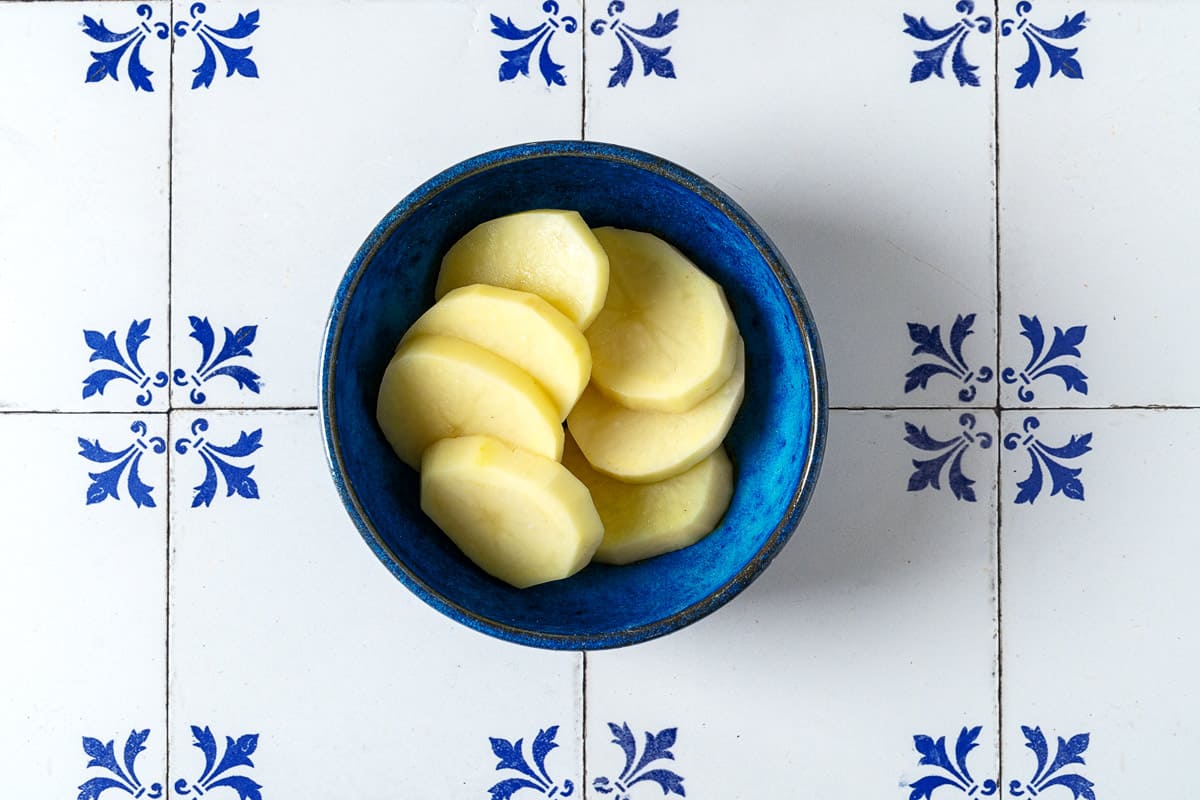
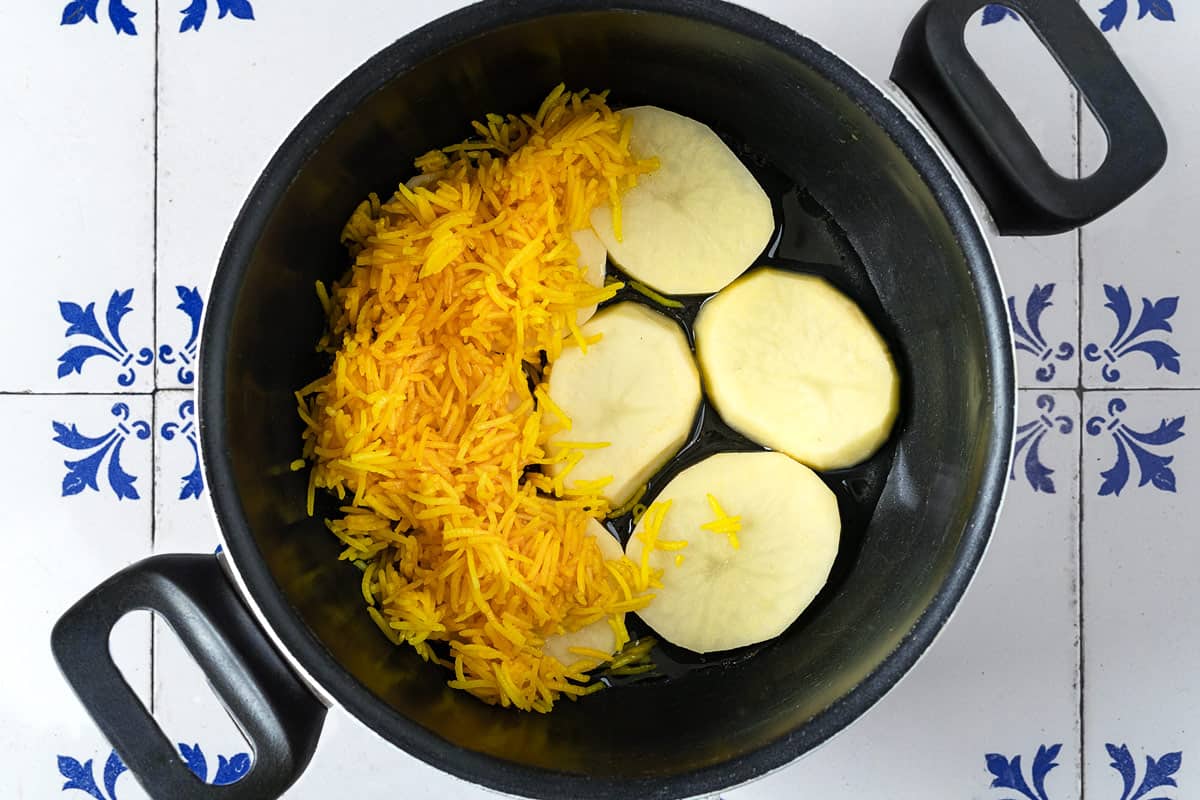
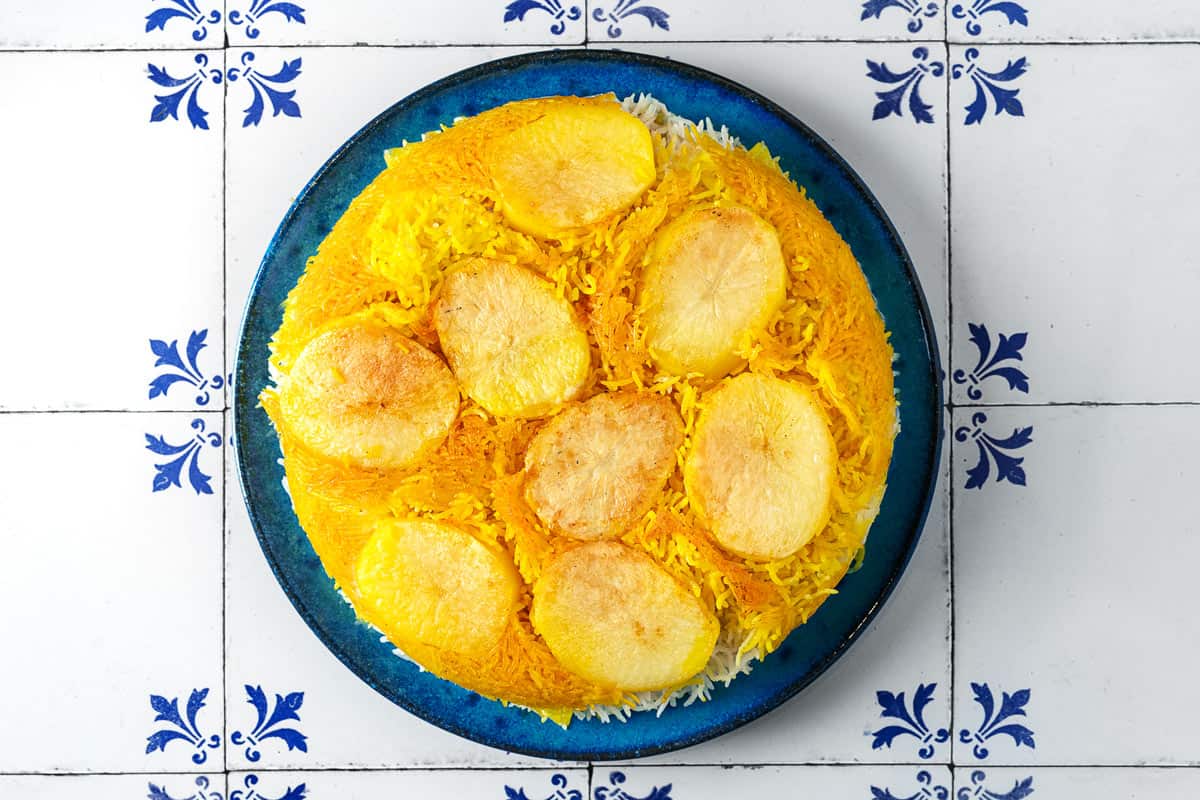
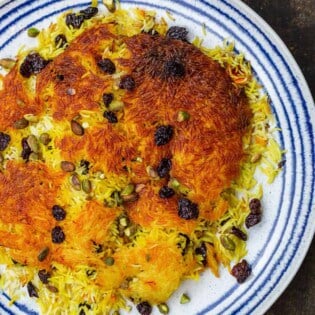
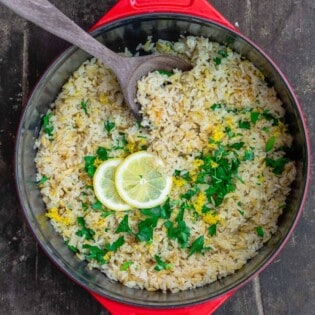
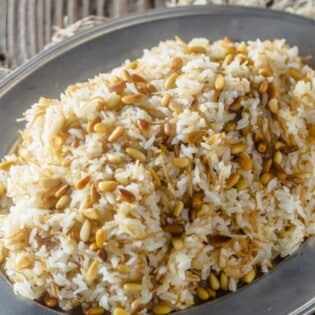
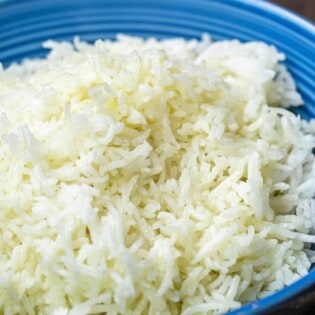
This became my wife’s new favorite thing. Served with Ghormeh Sabzi. I used a 14″ teflon skillet with a lid from my stockpot. Instead of the tea towel to hold the moisture I just used aluminum foil with the lid back on it snug as possible. The saffron was great, crispy potatoes were great and oh my crispy rice. Much love!
The inverted flip was challenging. I used a large cutting board and flipped it out. Came out clean and awesome looking.
Thanks so much for taking the time to comment and review, Dan!
I love this. I just followed the concept as I am pretty creative and have had the pleasure of seeing a friend book this for me many times. I didn’t have any saffron. used basmati rice. I had a wonderful time making this dish.
Really good comfort food that my family and guest enjoyed. Fairly easy to make, however, when I inverted the pot, the potatoes stayed in the bottom. How would you suggest I fix this for next time? Finally, I was wondering if I could add onions to the potato layer. Thoughts?
Hi, Paul. This is just something that happens every now and then with tahdig. When it does, just simply scrape the potatoes from the pan and place them nicely on top of the rest of the dish.
HI! I am new to Mediterranean food and am looking forward to trying this recipe? Is it possible to use Jasmine rice for this? And Is it possible to cook it in a rice cooker?
Thanks!
Hi, Kendra. Jasmine rice should work okay here in a pinch. I’m not sure about cooking it in a rice cooker, though, as that’s something we’ve never tested. If you give it a go, though, please stop back and let us know how it turned out for you!
Hello Mersedeh Prewer, I am a new follower and am enjoying your recipes. I wanted you to be aware that when you want to copy one of your recipes and you click the box to ‘Show Image’, it does not work so you have to copy a second page showing the photo to see how the completed dish looks. I pay per copy so having to pay for the extra sheet every time I want to have one of your recipes does add up. It would be great if you could fix this. Thank you so much, Cherie Ross
Hi, Cherie. This is Kate, one of the team members here at The Mediterranean Dish. I am so sorry, but the picture printing function on our recipes just isn’t working anymore. It’s something we’ve tried to fix, with no luck. Hopefully you can still enjoy the recipes anyway!